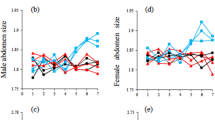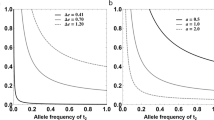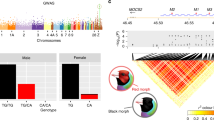Abstract
Exactly how the high genetic variance of traits involved in sexual selection through female mate choice is maintained is a much debated issue1,2,3. Theoretical models attempt to explain the high genetic variance of sexual traits, among others, by the evolution of condition dependence1,4, in which expression of the trait depends on physical condition. If it is costly to be choosy, then these models should also apply to female mate preference and predict that female condition affects the choice of mate. Here we allow female laboratory-bred three-spined sticklebacks, Gasterosteus aculeatus, to choose between computer animations of courting males5, and find that the choice of mate correlates well with female physical condition.
Similar content being viewed by others
Main
Heritability estimates of mate preference have accumulated in recent years: the average heritability (±s.d.) of mate preference in 15 species was 0.41 (±0.21) (ref. 3), which is high for a behavioural trait6. Condition dependence might explain the high heritability of costly mate preferences, as it does the high genetic variance in sexual traits1,4. Costs may include physiological as well as choice costs. Condition dependence of sexual traits is well known7, and there is some evidence for condition-dependent mate choice3,8. We have studied the covariance of condition and mate preference in a fish species that is well-known for intensive sexual selection2.
Sticklebacks were bred from wild-caught parents, and were raised and maintained under standardized laboratory conditions in full-sibling groups of similar size. Paternal effects on offspring traits were excluded by removing clutches from the fathers' nests one hour after fertilization. After reaching adult body size, fish were transferred from simulated summer to winter conditions, under which gonadal development and the development of male breeding coloration are suppressed.
Six months later, the condition factor9 of a random sample of males per full-sib group was assessed. Average male winter condition per group was taken as an index of group rearing condition because some females showed signs of egg production under the prolonged winter conditions. Male physical condition is not confounded by possible between-group variance in ovarian development. Females were randomly sampled from the full-sib groups about six months later and placed individually in 10-litre tanks under simulated summer conditions, where they became reproductive.
When females became ripe they were tested for their preference for red males by placing them in a one-litre cuvette in front of a computer monitor on which two virtual males that differed only in red breeding coloration (bright red or bright orange) were courting simultaneously5. In this preference test, males differ in only one trait, and there are no costs of choice.
Despite standardized rearing conditions, progeny from different fathers differed significantly in condition during rearing (ANOVA, F(10,67)=7.65, P<0.001) and in preference for red coloration (ANOVA, F(10,13)=3.52, P<0.02). Overall, there was no significant preference for the bright red male over the bright orange one (t-test, t=0.37, df=10, P>0.71), but average red preference and rearing condition per father correlated positively (r=0.77, N=11, P<0.01; Fig. 1). Females from groups with a high average condition factor before reproduction therefore preferred the red male, whereas those of lower rearing condition showed a preference for the orange male.
Females from one father were full siblings, except in three cases in which they had two different mothers, where the mean condition per father was weighted for the number of females tested per mother. Condition is calculated as 100×body mass (g)/body length3 (in cm) (ref. 9) and represents non-reproductive winter condition, estimated from data of 6 (range 2–9) randomly chosen males per full-sib group after one day of starvation. Mate preferences of 2 (range 1–5) ripe females per full-sib group were tested by using computer animations5. Females were given 2 min to choose between two ‘virtual’ males differing only in red throat coloration. We used standard colour chips to match the redness of the virtual males to those on standardized photographic slides of courting males. We selected bright red and bright orange males from the tails of the distribution of red intensity in the field based on densitometer-analysis10. Bright red and bright orange males differ mainly in hue (hue/saturation/brightness values of virtual males were 17°/100%/93% and 31°/97%/97%, respectively, as determined using Adobe Photoshop Version 4.0.1 software), probably because of differences in carotenoid composition11. Male position was alternated between tests. Choice behaviour was video-recorded from above to avoid observer bias. Preferences were calculated as the time directed towards one male divided by the time directed to both males (0.5 indicates no preference; 1, absolute preference for the red male; 0, absolute preference for the orange male). Only females that spawned within 24 h of the test with a live male were used.
Combined with condition dependence of sexual traits, the covariance of mate preferences with condition may have consequences for the evolution of both preferences and preferred sexual traits. Experiments must show whether mate preferences have condition-dependent expression. When mate preferences appear to be condition dependent, and assuming there is high genetic variance in condition4, pleiotropic effects of genes that influence condition would be expected to lead to high genetic correlations between sexual trait and mate preference. Alternatively, the covariance of mate preference with condition may be brought about by genetic covariance of sexual male traits with both female preference10 and male condition. The consequences of these alternatives should be explored using theoretical models of sexual selection.
References
Pomiankowski, A. & Møller, A. P. Proc. R. Soc. Lond. B 260, 21–29 (1995).
Bakker, T. C. M. & Pomiankowski, A. J. Evol. Biol. 8, 129–171 (1995).
Bakker, T. C. M. Behaviour (in the press).
Rowe, L. & Houle, D. Proc. R. Soc. Lond. B 263, 1415–1421 (1996).
Künzler, R. & Bakker, T. C. M. Behaviour 135, 1137–1159 (1998).
Roff, D. A. Evolutionary Quantitative Genetics (Chapman & Hall, New York, 1997).
Andersson, M. Sexual Selection (Princeton Univ. Press, 1994).
Jennions, M. D. & Petrie, M. Biol. Rev. 72, 283–327 (1997).
Bolger, T. & Connolly, P. L. J. Fish Biol. 34, 171–182 (1989).
Bakker, T. C. M. Nature 363, 255–257 (1993).
Wedekind, C. et al. J. Chem. Ecol. 24, 787–801 (1998).
Author information
Authors and Affiliations
Corresponding author
Rights and permissions
About this article
Cite this article
Bakker, T., Künzler, R. & Mazzi, D. Condition-related mate choice in sticklebacks. Nature 401, 234 (1999). https://doi.org/10.1038/45727
Issue Date:
DOI: https://doi.org/10.1038/45727
This article is cited by
-
Simulating individual movement in fish
Scientific Reports (2023)
-
Female cognitive performance and mass are correlated with different aspects of mate choice in the zebra finch (Taeniopygia guttata)
Animal Cognition (2019)
-
Advancing mate choice studies in salmonids
Reviews in Fish Biology and Fisheries (2019)
-
Female mate choice is not affected by mate condition in a fish with male care
acta ethologica (2013)
-
Direct mate choice for simultaneous acoustic and visual courtship displays in the damselfish, Dascyllus albisella (Pomacentridae)
Environmental Biology of Fishes (2013)
Comments
By submitting a comment you agree to abide by our Terms and Community Guidelines. If you find something abusive or that does not comply with our terms or guidelines please flag it as inappropriate.




